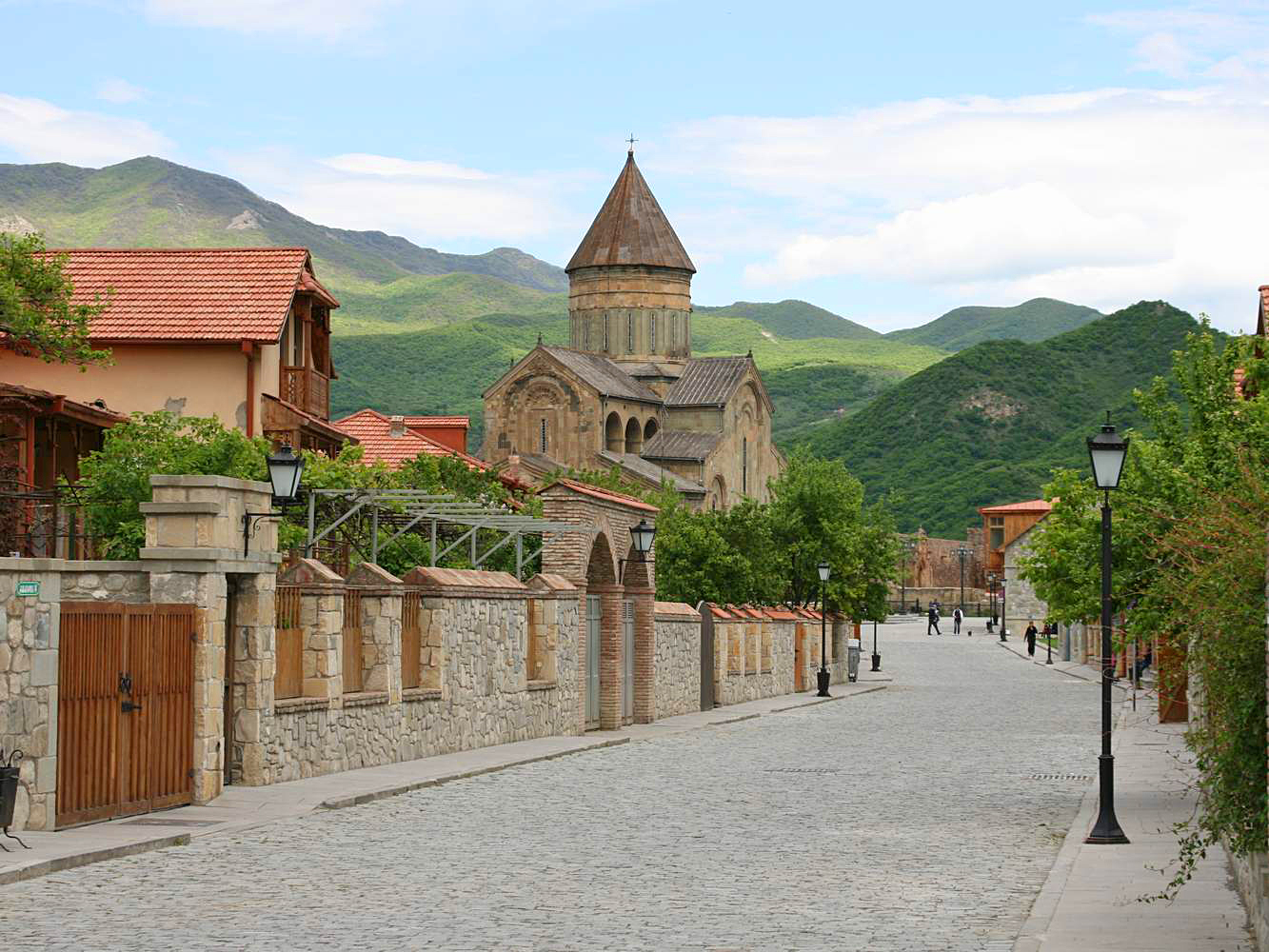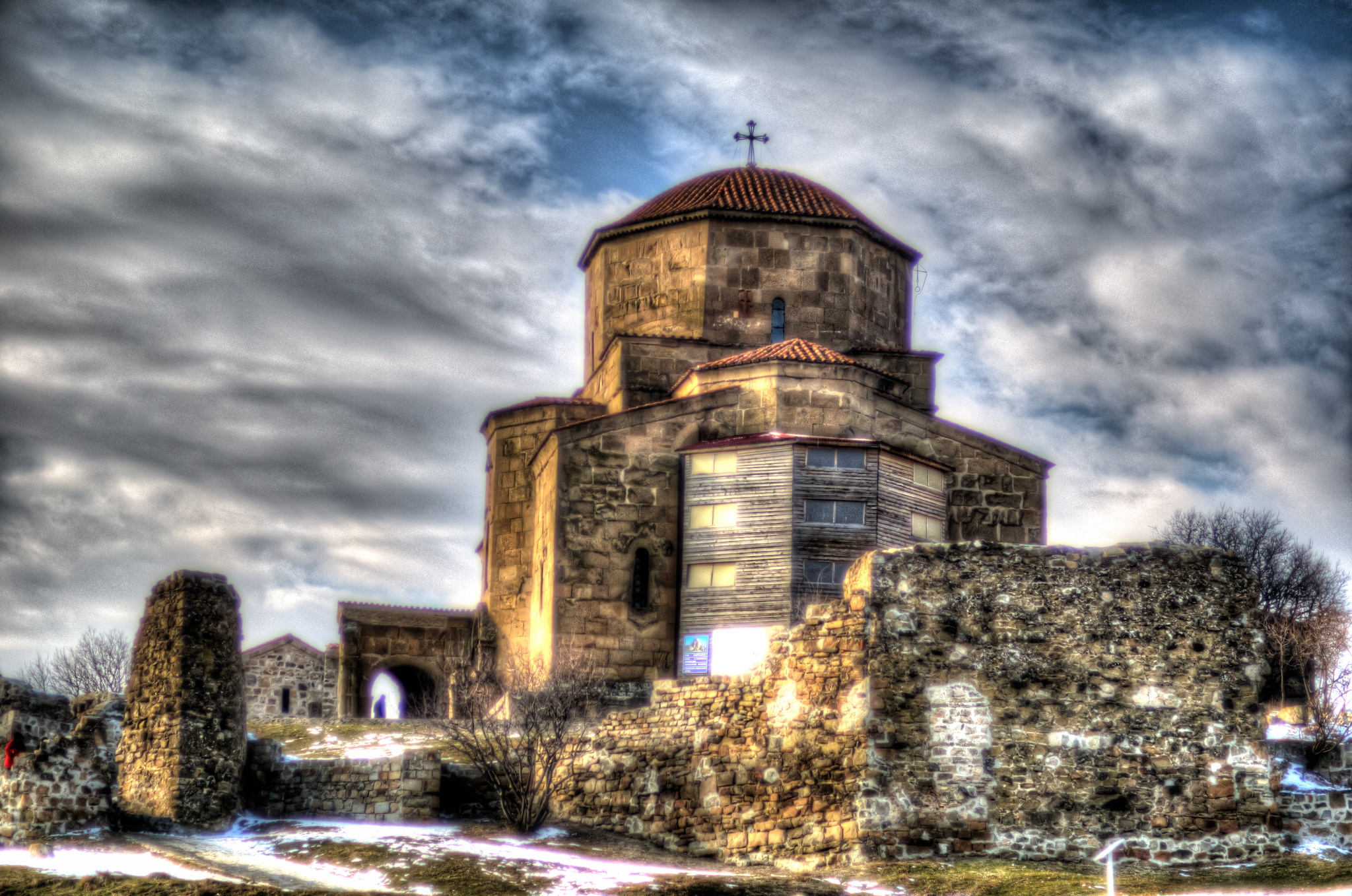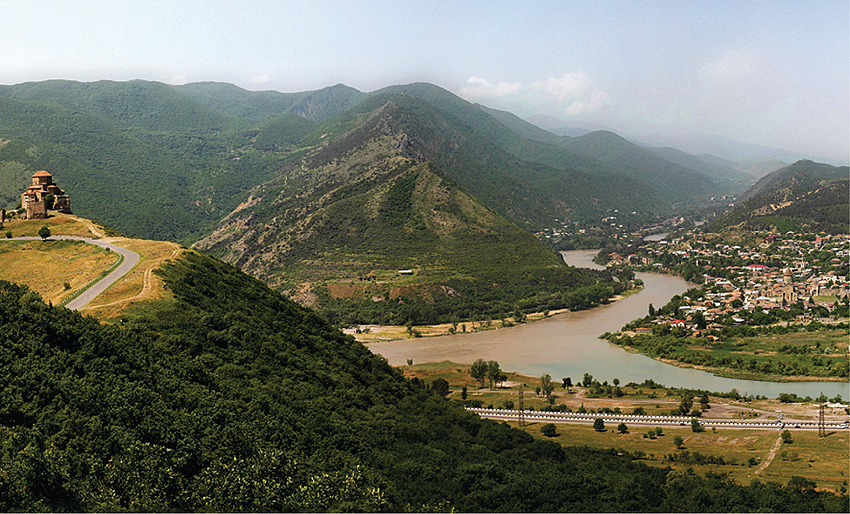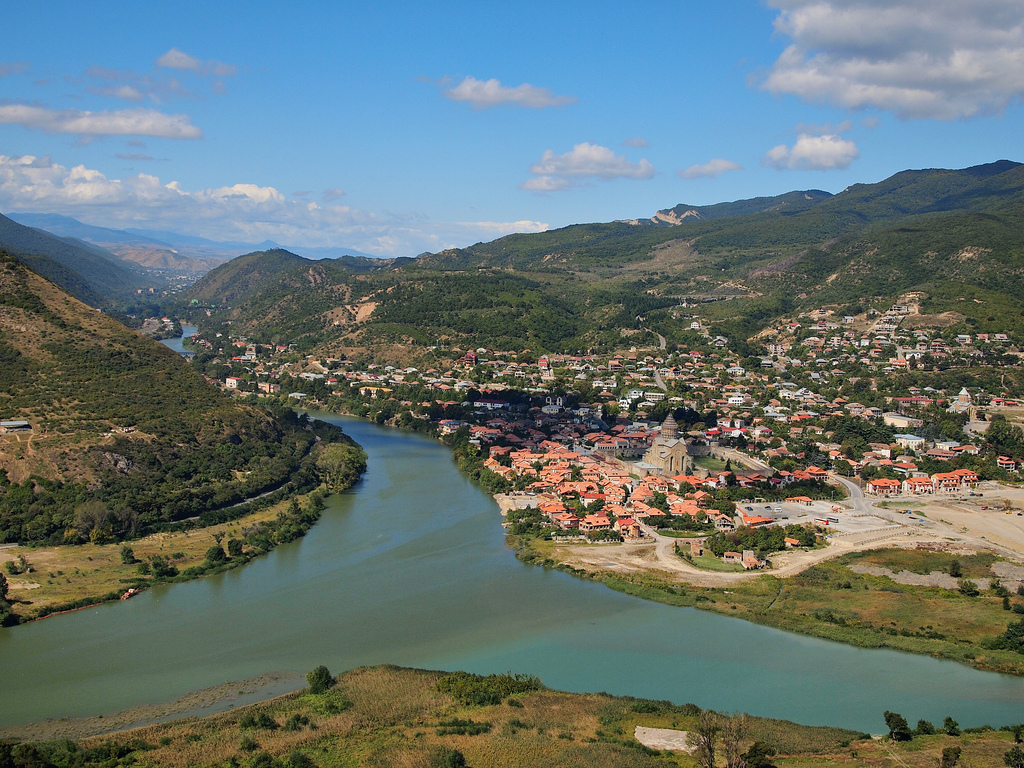Mtskheta - The Best of Georgia
Just 20 km from Tbilisi, at the confluence of the Mtkvari and Aragvi rivers, the city is located on an ancient trade route. Archaeologists have unearthed evidence of Mtskheta’s status as a major trading post. Glass perfume bottles, Greek and Aramaic writings, pottery, metalwork and jewelry have all been unearthed in abundance here, and many examples are on show in the town’s museum.
 Due to its historical significance and several cultural monuments, the "Historical Monuments of Mtskheta" became a UNESCO World Heritage Site in 1994.
Svetitskhoveli Cathedral (11th century) and Jvari Monastery (6th century) in Mtskheta are amongst the most significant monuments of Georgian Christian architecture
Due to its historical significance and several cultural monuments, the "Historical Monuments of Mtskheta" became a UNESCO World Heritage Site in 1994.
Svetitskhoveli Cathedral (11th century) and Jvari Monastery (6th century) in Mtskheta are amongst the most significant monuments of Georgian Christian architecture
 Svetistkhoveli Cathedral is the second largest church building in the country, after the recently consecrated Holy Trinity Cathedral of Tbilisi, and is listed as an UNESCO World Heritage Site along with other historical monuments of Mtskheta.
Svetistkhoveli Cathedral is the second largest church building in the country, after the recently consecrated Holy Trinity Cathedral of Tbilisi, and is listed as an UNESCO World Heritage Site along with other historical monuments of Mtskheta.
 Svetitskhoveli, known as the burial site of Christ's mantle, has long been the principal Georgian church and remains one of the most venerated places of worship to this day. The current cathedral was built in the eleventh century by the architect Arsukisdze, though the site itself is even older dating back to the early fourth century and is surrounded by a number of legends associated primarily with the early Christian traditions.
Svetitskhoveli, known as the burial site of Christ's mantle, has long been the principal Georgian church and remains one of the most venerated places of worship to this day. The current cathedral was built in the eleventh century by the architect Arsukisdze, though the site itself is even older dating back to the early fourth century and is surrounded by a number of legends associated primarily with the early Christian traditions.
 Jvari Monastery is a sixth century Georgian Orthodox monastery. Jvari Monastery stands on the rocky mountaintop at the confluence of the Mtkvari and Aragvi rivers, overlooking the town of Mtskheta, which was formerly the capital of the Kingdom of Iberia.
Jvari Monastery is a sixth century Georgian Orthodox monastery. Jvari Monastery stands on the rocky mountaintop at the confluence of the Mtkvari and Aragvi rivers, overlooking the town of Mtskheta, which was formerly the capital of the Kingdom of Iberia.
 According to traditional accounts, on this location in the early 4th century Saint Nino, a female evangelist credited with converting King Mirian III of Iberia to Christianity, erected a large wooden cross on the site of a pagan temple. The cross was reportedly able to work miracles and therefore drew pilgrims from all over the Caucasus. A small church was erected over the remnants of the wooden cross in c.545 named the "Small Church of Jvari".
According to traditional accounts, on this location in the early 4th century Saint Nino, a female evangelist credited with converting King Mirian III of Iberia to Christianity, erected a large wooden cross on the site of a pagan temple. The cross was reportedly able to work miracles and therefore drew pilgrims from all over the Caucasus. A small church was erected over the remnants of the wooden cross in c.545 named the "Small Church of Jvari".
 In the outskirts of Mtskheta are the ruins of Armaztsikhe fortress (3rd century BC), the Armaztsikhe acropolis (dating to the late 1st century BC), remains of a "Pompey's bridge" (according to legends built by Roman legionnaires of Pompey the Great in 1st century BC), the fragmentary remains of a royal palace (1st–3rd century AD), a nearby tomb of the 1st century AD, a small church of the 4th century, the Samtavro Monastery (11th century), and the fortress of Bebris Tsikhe (14th century). The Institute of Archaeology, and the garden of Mikheil Mamulashvili are also worthy of note.
Today, the lovely old town has a laid back, village feel, especially compared to the more hectic pace of Tbilisi.
Credit: Georgia.Travel ; wikipedia
In the outskirts of Mtskheta are the ruins of Armaztsikhe fortress (3rd century BC), the Armaztsikhe acropolis (dating to the late 1st century BC), remains of a "Pompey's bridge" (according to legends built by Roman legionnaires of Pompey the Great in 1st century BC), the fragmentary remains of a royal palace (1st–3rd century AD), a nearby tomb of the 1st century AD, a small church of the 4th century, the Samtavro Monastery (11th century), and the fortress of Bebris Tsikhe (14th century). The Institute of Archaeology, and the garden of Mikheil Mamulashvili are also worthy of note.
Today, the lovely old town has a laid back, village feel, especially compared to the more hectic pace of Tbilisi.
Credit: Georgia.Travel ; wikipedia
 Due to its historical significance and several cultural monuments, the "Historical Monuments of Mtskheta" became a UNESCO World Heritage Site in 1994.
Svetitskhoveli Cathedral (11th century) and Jvari Monastery (6th century) in Mtskheta are amongst the most significant monuments of Georgian Christian architecture
Due to its historical significance and several cultural monuments, the "Historical Monuments of Mtskheta" became a UNESCO World Heritage Site in 1994.
Svetitskhoveli Cathedral (11th century) and Jvari Monastery (6th century) in Mtskheta are amongst the most significant monuments of Georgian Christian architecture
Svetitskhoveli Cathedral
 Svetistkhoveli Cathedral is the second largest church building in the country, after the recently consecrated Holy Trinity Cathedral of Tbilisi, and is listed as an UNESCO World Heritage Site along with other historical monuments of Mtskheta.
Svetistkhoveli Cathedral is the second largest church building in the country, after the recently consecrated Holy Trinity Cathedral of Tbilisi, and is listed as an UNESCO World Heritage Site along with other historical monuments of Mtskheta.
 Svetitskhoveli, known as the burial site of Christ's mantle, has long been the principal Georgian church and remains one of the most venerated places of worship to this day. The current cathedral was built in the eleventh century by the architect Arsukisdze, though the site itself is even older dating back to the early fourth century and is surrounded by a number of legends associated primarily with the early Christian traditions.
Svetitskhoveli, known as the burial site of Christ's mantle, has long been the principal Georgian church and remains one of the most venerated places of worship to this day. The current cathedral was built in the eleventh century by the architect Arsukisdze, though the site itself is even older dating back to the early fourth century and is surrounded by a number of legends associated primarily with the early Christian traditions.
Jvari Monastery
 Jvari Monastery is a sixth century Georgian Orthodox monastery. Jvari Monastery stands on the rocky mountaintop at the confluence of the Mtkvari and Aragvi rivers, overlooking the town of Mtskheta, which was formerly the capital of the Kingdom of Iberia.
Jvari Monastery is a sixth century Georgian Orthodox monastery. Jvari Monastery stands on the rocky mountaintop at the confluence of the Mtkvari and Aragvi rivers, overlooking the town of Mtskheta, which was formerly the capital of the Kingdom of Iberia.
 According to traditional accounts, on this location in the early 4th century Saint Nino, a female evangelist credited with converting King Mirian III of Iberia to Christianity, erected a large wooden cross on the site of a pagan temple. The cross was reportedly able to work miracles and therefore drew pilgrims from all over the Caucasus. A small church was erected over the remnants of the wooden cross in c.545 named the "Small Church of Jvari".
According to traditional accounts, on this location in the early 4th century Saint Nino, a female evangelist credited with converting King Mirian III of Iberia to Christianity, erected a large wooden cross on the site of a pagan temple. The cross was reportedly able to work miracles and therefore drew pilgrims from all over the Caucasus. A small church was erected over the remnants of the wooden cross in c.545 named the "Small Church of Jvari".
 In the outskirts of Mtskheta are the ruins of Armaztsikhe fortress (3rd century BC), the Armaztsikhe acropolis (dating to the late 1st century BC), remains of a "Pompey's bridge" (according to legends built by Roman legionnaires of Pompey the Great in 1st century BC), the fragmentary remains of a royal palace (1st–3rd century AD), a nearby tomb of the 1st century AD, a small church of the 4th century, the Samtavro Monastery (11th century), and the fortress of Bebris Tsikhe (14th century). The Institute of Archaeology, and the garden of Mikheil Mamulashvili are also worthy of note.
Today, the lovely old town has a laid back, village feel, especially compared to the more hectic pace of Tbilisi.
Credit: Georgia.Travel ; wikipedia
In the outskirts of Mtskheta are the ruins of Armaztsikhe fortress (3rd century BC), the Armaztsikhe acropolis (dating to the late 1st century BC), remains of a "Pompey's bridge" (according to legends built by Roman legionnaires of Pompey the Great in 1st century BC), the fragmentary remains of a royal palace (1st–3rd century AD), a nearby tomb of the 1st century AD, a small church of the 4th century, the Samtavro Monastery (11th century), and the fortress of Bebris Tsikhe (14th century). The Institute of Archaeology, and the garden of Mikheil Mamulashvili are also worthy of note.
Today, the lovely old town has a laid back, village feel, especially compared to the more hectic pace of Tbilisi.
Credit: Georgia.Travel ; wikipedia

 ეკლესია-მონასტრები
ეკლესია-მონასტრები
 13 მარტი 2016
13 მარტი 2016

 18098
18098
 გაზიარება
გაზიარება


